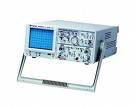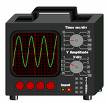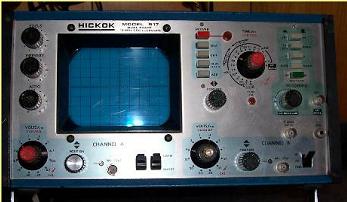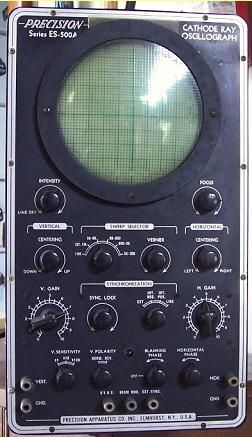Recording of electrical processes using electron beam oscilloscopes
Application of cathode ray oscilloscopes
An electron beam oscilloscope is a multifunctional measuring device that allows you to visually observe and record random, single aperiodic and periodic electrical processes in the frequency range from zero (direct current) to gigahertz units. In addition to the qualitative assessment of the studied processes, the oscilloscope allows you to measure:
-
amplitude and instantaneous value of current and voltage;
-
time parameters of the signal (duty cycle, frequency, rise time, phase, etc.);
-
phase shift; frequency of harmonic signals (method of Lissajous figures and circular sweep),
-
amplitude-frequency and phase characteristics, etc.
 An oscilloscope can be used as a component of more complex measuring equipment, for example in bridge circuits as a null organ, in frequency response meters, etc.
An oscilloscope can be used as a component of more complex measuring equipment, for example in bridge circuits as a null organ, in frequency response meters, etc.
The high sensitivity of the oscilloscope determines the possibility of studying very weak signals, and the high input impedance causes its small effect on the modes of the studied circuits. By convention, cathode oscilloscopes are divided into universal and general purpose (type C1), high-speed and stroboscopic (type C7), memory (type C8), special (type C9), recording with recording on photo paper (type H). All of them can be single-, double- and multi-beam.
General purpose oscilloscopes
 Universal oscilloscopes are versatile due to the use of replaceable devices (for example, preamplifiers in C1-15). The bandwidth is from 0 to hundreds of megahertz, the amplitude of the investigated signal is from tens of microvolts to hundreds of volts. General-purpose oscilloscopes are used to study low-frequency processes, pulse signals. They have a frequency band from 0 to tens of megahertz, the amplitude of the studied signal from units of millivolts to hundreds of volts.
Universal oscilloscopes are versatile due to the use of replaceable devices (for example, preamplifiers in C1-15). The bandwidth is from 0 to hundreds of megahertz, the amplitude of the investigated signal is from tens of microvolts to hundreds of volts. General-purpose oscilloscopes are used to study low-frequency processes, pulse signals. They have a frequency band from 0 to tens of megahertz, the amplitude of the studied signal from units of millivolts to hundreds of volts.
High speed oscilloscopes
High-speed oscilloscopes are designed to record single and repetitive pulse signals in a frequency band of the order of several gigahertz.
Strobe oscilloscopes
Strobe oscilloscopes are designed for examining high-speed repetitive signals in the frequency range from zero to gigahertz, with the amplitude of the signal being examined from millivolts to volts.
Storage of oscilloscopes
Storage oscilloscopes are designed to record single and infrequently repeating signals. The bandwidth is up to 20 MHz with the studied signal amplitude from tens of millivolts to hundreds of volts. Playback time of a recorded image from 1 to 30 minutes.
To record fast and transient processes on photographic paper, electron beam oscilloscopes with a photo-optical method of transferring the beam to a recording medium are used, for example H023. High recording speed (up to 2000 m / s) and a large range of recorded frequencies (up to hundreds of kilohertz) allow the use of these oscilloscopes, if it is impossible to use those with light beams that have a relatively low recording speed and range of recorded frequencies. The main technical characteristics of the H023 and H063 oscilloscopes are given in the reference books.

Application of light beam oscilloscopes
In order to obtain a visible record of fast processes, the most common are light beam oscilloscopes with recording on special oscillographic photo paper sensitive to ultraviolet rays.
 The main advantage of light beam oscilloscopes is the ability to obtain a visible recording in rectangular coordinates in a large dynamic range (up to 50 dB). The operating frequency band of light beam oscilloscopes does not exceed 15,000 Hz, the maximum recording speed for light beam oscilloscopes is up to 2000 m / s, for electrographic illuminated light beams 6-50 m / s. For the simultaneous observation and recording of several electrical processes, oscilloscopes have several oscillographic galvanometers (usually a magnetoelectric system), the number of which can reach 24 (in an oscilloscope H043.2) and more.
The main advantage of light beam oscilloscopes is the ability to obtain a visible recording in rectangular coordinates in a large dynamic range (up to 50 dB). The operating frequency band of light beam oscilloscopes does not exceed 15,000 Hz, the maximum recording speed for light beam oscilloscopes is up to 2000 m / s, for electrographic illuminated light beams 6-50 m / s. For the simultaneous observation and recording of several electrical processes, oscilloscopes have several oscillographic galvanometers (usually a magnetoelectric system), the number of which can reach 24 (in an oscilloscope H043.2) and more.
Oscillography can be performed on UV photographic paper or photographic film with chemical photographic development.Oscillography on UV paper is performed by a mercury lamp with direct light development, which significantly speeds up the oscillography process, and is used in cases where you need to obtain, for example, a test oscillogram. The disadvantage of UV photo paper is that the oscillograms obtained on it lose contrast over time due to the darkening of the background. The sensitivity of the photo paper and the brightness of the illumination should be selected as high as the speed of the oscillography and set by taking test oscillograms.
Oscilloscopes are usually equipped with galvanometers with different operating frequency bands. When using a galvanometer whose operating frequency is unknown, the upper frequency limit may be taken equal to half the natural frequency of the galvanometer. The natural frequency of the galvanometer is indicated on it by a dash after the type designation. Standard shunt boxes and additional resistors are used to limit the operating current of the galvanometer. For oscillographic cases of high currents (more than 6 A) or high voltages (more than 600 V), instrument transformers are usually used.
To get the largest swing of the beam on the oscillogram (70-80% of the width of the paper used), you need to choose a galvanometer whose operating current will be close to the maximum.
The most widely used types of light beam oscilloscopes and their basic technical data are given in reference books.
